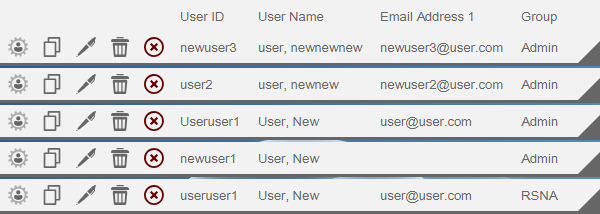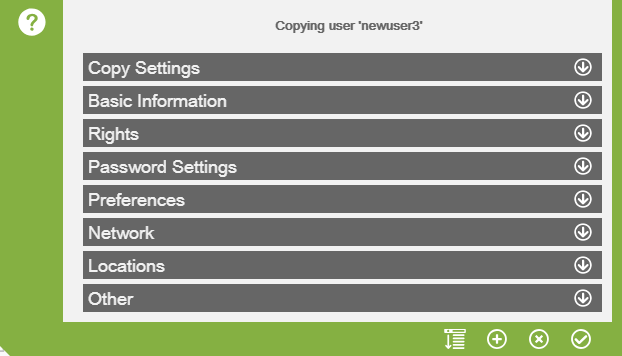 eRAD
PACS Server
eRAD
PACS Server

 eRAD
PACS Server
eRAD
PACS Server

The User Accounts page allows administrators to add, edit and remove user accounts, assign group affiliations, specify user rights, review user profile information, and find out when a user last accessed the system, and from where. To display the Users list, select Admin/User Accounts from the menu.
Note: Before creating user accounts, user groups must be defined.
See: User Groups
Below is an example of the user page with icons to the left that perform various functions:

![]() - Copy user (Copy)
- Copy user (Copy)
![]() - Edit user information
(Editing
User Information)
- Edit user information
(Editing
User Information)
![]() - Delete user (Deleting a User)
- Delete user (Deleting a User)
![]() - User log-in information
(green when user is active)
- User log-in information
(green when user is active)
The group of icons on the right allows for adding new users ,editing the layout of the worklist, export the worklist, and sorting of the worklist:

 - Sort user name in ascending
order
- Sort user name in ascending
order
![]() - Edit layout
- Edit layout
![]() - exports user accounts
list to a .csv file
- exports user accounts
list to a .csv file
 - Add user
- Add user
 - Search for a user
- Search for a user

Use the User Accounts page to add a new user account to eRAD PACS. The eRAD PACS license defines the maximum number of supported user accounts. Before creating user accounts, define your user groups. User groups consist of default settings, such as privileges, worklists, filters, and viewer profiles. Assigning a user account to a group is required.
To add a new user select the Add User  icon.
icon.

When creating a new user account, import all the settings from an existing account using the copy user function from the Admin/User Accounts page.
When creating multiple users from a single existing user account, use the Save button appearing after the Phone Number 2 field to save the entered values and open another new user page using the same template account. The password defaults to <userid>1 and is required to change after the first login. If you modify the user rights or enter a password on this page, those values will be used in place of the default.

The administrator is able to create a new user and copy settings from
a selected user. When the copy user ![]() icon is
selected next to a user name, the new user will have the same settings
as the selected user (highlighted below).
icon is
selected next to a user name, the new user will have the same settings
as the selected user (highlighted below).

An administrator can create a new user in the text field (highlighted below) who will have the same copied settings.

Below are all of the settings that can be
copied. Select the expand icon ![]() to reveal all settings. Select the collapse icon
to reveal all settings. Select the collapse icon ![]() to close all settings.
to close all settings.

The list of icons in the bottom right hand corner perform various functions:
![]() - (Expand all)
Expands all settings
- (Expand all)
Expands all settings
 - (Save and add user)
Saves current new user name and creates a copy for a new user to be
created
- (Save and add user)
Saves current new user name and creates a copy for a new user to be
created
![]() - (Cancel) Cancels all
actions
- (Cancel) Cancels all
actions
![]() - (Save) Saves all actions
- (Save) Saves all actions

To delete a user:

When the edit icon ![]() is selected,
a person with administrative rights designated by their facility can modify
or delete user information.
is selected,
a person with administrative rights designated by their facility can modify
or delete user information.
In this section, the administrator can change personal information such as e-mail, phone numbers, as well as what group the user may be in (physician, technologist, etc.).

In this section, a user is allowed rights such as administrative rights, editing reports, scheduling as well as Plugin rights.

| Basic Rights | Description |
| Accounting | Access to the account summary information |
| Admin | Administrative rights. Admin permissions override other permission settings with the following exceptions: Scan, Scheduling, Dump |
| Allow multiple sessions | Allow concurrent active login sessions |
| Allow outside scope searches | User can search for studies outside of applied restriction |
| Archive | Access to the archived data, including third-party archives |
| Break Locks | User is permitted to break locks held by other users |
| CD Importing | Import studies from CD/DVD using Media Import feature |
| CTRM | Create and monitor CTRM messages. Available if CTRM license is installed. |
| Copy | Create a copy of a study in a folder |
| Correction | Manipulate the correction queue |
| Create View | Save a worklist view (filter) |
| Delete | Purge studies from the server |
| Display Logs | Display the system logs |
| Dump | Dump DICOM data |
| Edit Advanced Settings | User is permitted to edit the viewer’s Advanced settings |
| Edit Memory Settings | User is permitted to edit the viewer's memory settings |
| Edit Overlay Fields | User is permitted to edit the viewer's overlay field configuration |
| Edit Prefetch Settings | User is permitted to edit the viewer’s prefetch settings. This does not affect the user’s ability to define or edit the prefetch worklist filter. |
| Edit report | Edit the report text or upload post-processed images. See the table below for dependent permissions |
| Edit study | Edit study information, including uploading post-processed images from the eRAD PACS viewer |
| Forward/Export | Send a set of images to a configured destination |
| Open | Open the eRAD PACS viewer and view images stored on the server. See the table below for dependent permissions |
| Restricted Query | The ability to perform queries that exceed the maximum query time |
| Scan/Upload | Scan documents into PACS and/or Scheduler |
| Scheduling | Access the Scheduler pages. Available when eRAD Scheduler is licensed. See the table below for dependent permissions |
| Set Status | Set study status. Implicitly assigned to users with Report or Transcribe permissions |
| Worklist Configuration | Modify the worklist table settings |
Edit Report permissions are required before the following can be assigned:
| Permission | Code | Description |
| Approve | R |
Approve a report |
| Dictate | J |
Create a dictated report |
| Note | K |
Enter or edit a note |
Open permissions are required before the following can be assigned:
| Permission | Code | Description |
| DICOM Printing | P | Print film using DICOM print from the viewer |
| Plugin Rights | Description |
| 3D Volume Rendering | |
| AVI Player | |
| Advanced Imaging Enhancement | |
| Dragon Naturally Speaking | |
| Image Fusion | |
| Image Stitching Tool | |
| Initiate Radar Conversation | |
| Mammography Module | |
| Mask Subtraction | |
| Multi-planar reconstruction | |
| SpeechMike |
See: Change Password

See: Preferences Page



